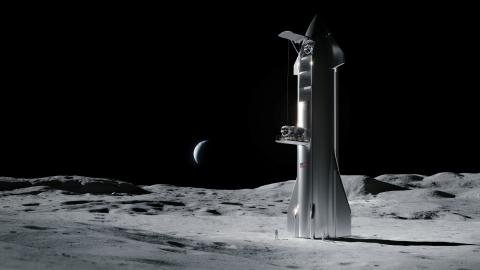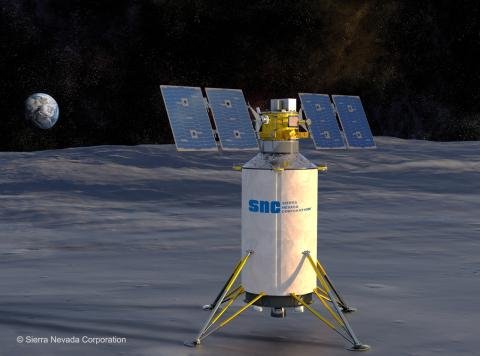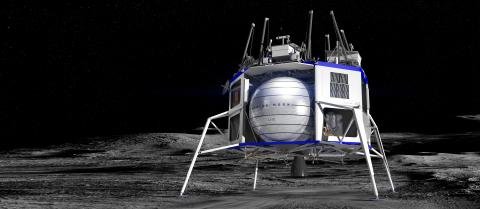
In its ongoing effort to send cargo — and eventually people — to the lunar surface, NASA announced five new partnerships with commercial space companies that have designed robotic landers that can take large payloads to the Moon. The additions include some well-known industry heavyweights, such as SpaceX, Blue Origin, and Sierra Nevada Corporation, which have already partnered with NASA for other projects.
The newcomers will join an already formed pool of nine companies that are part of NASA’s fledgling CLPS program, which stands for Commercial Lunar Payload Services. The goal is to have multiple different capabilities for transporting scientific instruments and cargo to the Moon, as NASA attempts to send people back to the lunar surface by 2024.
The newcomers will join an already formed pool of nine companies
Being chosen to be part of the CLPS program doesn’t guarantee each company a NASA contract to send their spacecraft to the Moon. It simply means that NASA will consider using these companies if and when it wants to send cargo or scientific instruments to the lunar surface. NASA will put out calls for capabilities that the agency wants, and the companies will bid to have the opportunity to ferry NASA’s cargo to the Moon. In May, NASA selected three companies from its original pool of participants — Astrobotic, Intuitive Machines, and Orbit Beyond — to send robotic landers to the Moon in the early 2020s, with each spacecraft carrying a variety of payloads. Only two of those companies are continuing toward that goal now, as Orbit Beyond said it would not be able to meet its late 2020 deadline

The companies being added today — SpaceX, Blue Origin, Sierra Nevada Corporation, Ceres Robotics, Tyvak Nano-Satellite Systems Inc. — all vow to transport much heavier payloads than what the original nine CLPS companies say they can carry. The original nine companies needed to be able to carry up to 22 pounds (10 kilograms) to the lunar surface, but some of these new providers claim they will eventually be able to carry several tons to the Moon. “We have a need and saw a need to bring on some additional providers that had enhanced lander capabilities,” Steve Clarke, deputy associate administrator for exploration in NASA’s Science Mission Directorate, said during a press conference announcing the new CLPS participants. “This is based on our objectives — the agency’s objectives — to get to the moon as soon as possible, both from a scientific standpoint and from a human exploration standpoint.”
“We have a need and saw a need to bring on some additional providers.”
Thanks to a challenge from Vice President Mike Pence, NASA is scrambling to send humans back to the Moon within the next four years. As the agency prepares to meet that challenge, NASA wants to send tech to the Moon to study the lunar environment more in-depth, as well as demonstrate technologies that might be used for future human missions. Additionally, NASA wants to send a new rover to the Moon called VIPER, which will travel to the lunar south pole and scout for potential water ice that might be lurking there. Engineers are interested in using this water ice as a resource for future human missions.
For Blue Origin, the company is bidding its very public Blue Moon lander design, which founder Jeff Bezos first unveiled in May. Meanwhile, SpaceX is offering up its future Starship spacecraft, which the company has been building at its test sites in Boca Chica, Texas, and Cape Canaveral, Florida. SpaceX president Gwynne Shotwell claims Starship, which is designed to take off from the Moon after landing on it, can bring up to 100 metric tons to the lunar surface

Some of the companies are fairly ambitious with their timelines, claiming they’ll be able to send their spacecraft to the Moon within the next few years. Ceres Robotics is aiming to land by 2023, while SNC says it will be ready by 2022. SpaceX, which is proposing the largest lander of all five companies, says it is trying to land a cargo version of Starship on the Moon by 2022. “Starship right now, the early missions we’re very focused on on cargo — both satellite delivery to orbit, science delivery to the surface of the Moon,” Shotwell said during today’s press conference. After that, the company will focus on putting people on board Starship.
None of these five companies have actually built or launched their vehicles yet, so it’s likely their timelines will be delayed, and it’s still unclear exactly which rockets will take these vehicles to space. Presumably, SpaceX will launch its Starship on its own future rocket, the Super Heavy, while Blue Origin’s lander will fly on the company’s future New Glenn rocket. The details for the other cargo spacecraft have not been finalized yet, and it’s still unknown how NASA plans to use these companies in the years ahead.
In the meantime, NASA is still searching for the lander that will take humans to the surface of the Moon. The agency recently put out a call for proposals with final submissions due by November 1st. A decision on that crucial piece of technology should come in the months ahead
Authors get paid when people like you upvote their post.
If you enjoyed what you read here, create your account today and start earning FREE STEEM!
If you enjoyed what you read here, create your account today and start earning FREE STEEM!
Hi! I am a robot. I just upvoted you! I found similar content that readers might be interested in:
https://www.theverge.com/2019/11/18/20971307/nasa-clps-program-spacex-blue-origin-sierra-nevada-ceres-tyvak-viper-rover
Downvoting a post can decrease pending rewards and make it less visible. Common reasons:
Submit
Congratulations @thakordtube19! You have completed the following achievement on the Steem blockchain and have been rewarded with new badge(s) :
You can view your badges on your Steem Board and compare to others on the Steem Ranking
If you no longer want to receive notifications, reply to this comment with the word
STOPVote for @Steemitboard as a witness to get one more award and increased upvotes!
Downvoting a post can decrease pending rewards and make it less visible. Common reasons:
Submit